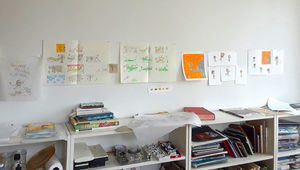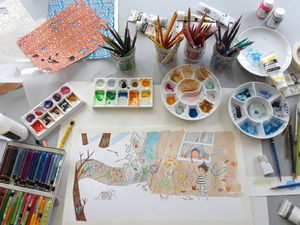Marie-Louise Gay's Celebration of Young Readers' Imaginations in Fern and Horn: "You Have Your Unique Wonderful Way of Seeing the World"
In Fern and Horn (Groundwood Books), the titular twins Fern and Horn might be small, but their imaginations are huge. Fern loves drawing and helps Horn unlock his love of drawing too - the only trouble with that is that when Fern draws flowers, Horn draws an elephant who stomps all over them. When Fern draws a castle that can keep an elephant out, Horn draws a castle-destroying dragon. But Fern's got lots of tricks up her sleeve, and she and Horn will keep challenging each other to bigger and more wildly imaginative creations, all rendered in beautiful and vibrant colour and collage.
It's no surprise this magical adventure of creativity comes from Marie-Louise Gay, one of the most acclaimed and imaginative picture book authors and illustrators working today. A love letter to children's imaginations, Fern and Horn is a celebratory and gorgeous addition to Gay's internationally beloved library of works.
We're thrilled to welcome Marie-Louise to Open Book today as part of our Kids Club interview series for authors of young people's literature. She not only shares with us about her process but also gives us a peek into her Montreal studio (photos below), tells us about some of the misconceptions about writing for young readers, and champions the need to allow children to experience a story in their own way.
Open Book:
Tell us about your new book and how it came to be.
Marie-Louise Gay:
Fern and Horn is the story of twins who look like peas in a pod. They are creative, imaginative and curious, but when it comes to reinventing the world around them with vivid colours, crayons and scissors, scraps of paper and cardboard boxes, they are very different. As they paint and draw, scribble and paste, creating flowers and birds, elephants and starry trees, raggedy polar bears and fire-breathing dragons, they are creating their unique joyful and chaotic story.
From my studio window in Montreal, I look out onto small urban gardens and an alleyway shaded by tall old trees, I see children playing games, parading branches and sticks, hiding in boxes or behind trees, wearing capes or paper crowns, drawing colourful chalk monsters or long wavey landscapes. I hear them laugh and scream and tell stories.
With Fern and Horn, I wanted to write a story that celebrates children's marvellous creativity that springs from their imaginative powers, as long as they are given time and space and freedom to explore the world on their own.
OB:
Is there a message you hope kids might take away from reading your book?
MLG:
I don't like writing stories that contain obvious, unavoidable messages or lessons for children. I want to write stories that will capture their imagination. Stories that contain emotions that they can identify with, that make them reflect, laugh or gasp in surprise or discover something new. But there are always subtle messages that seem to slip into the story inadvertently, as in the case of Fern and Horn, when Horn wants to draw like his sister, he is disappointed:
"...But Horn thinks that his flowers look like purple pancakes.
Your CanLit News
Subscribe to Open Book’s newsletter to get local book events, literary content, writing tips, and more in your inbox
That his caterpillars look like striped socks. That his birds look like witches hats.
"I can't draw flowers," grumbles Horn. "Or birds or stripy caterpillars."
"Draw whatever you want," says Fern.
"Elephants!" says Horn." I am good at drawing elephants..."
A discreet message of encouragement to children who doubt their creative abilities: try to find what you like to create... Do not despair, do not compare, you have your unique wonderful way of seeing the world. I meet too many children who suffer because of this. I was one of them.
But it is important for me that this message be just a small part of the story and not the main theme.
OB:
Do you feel like there are any misconceptions about writing for young people? What do you wish people knew about what you do?
MLG:
Most people think writing for young children is effortless. That it can't be that difficult to produce a manuscript for a picture-book that is two, four or six pages long. They are quite impressed with the drawing skills required but the writing doesn't seem to faze them. After all, most adults, teachers or parents, can tell stories... why not just write them down? But of course that is completely different.
The difficulty lies in conveying emotion, developing characters and a plot with so few words. The writing has to be rhythmical and fluid to direct the adult who is reading to a child who cannot read. The images enrich the story, add new elements and details to it and are read with great attention by the children. This also affects the writing since the author has to pare things down to the essential elements. But as well, creating a child’s voice and visualizing a child’s point of view when our own childhood is far behind us is not an easy task.
A book can take six months to a year to two years to come to fruition. Some of my projects have evolved and meandered in my mind for years before I started putting pencil to paper and making notes.
OB:
What defines a great book for young readers, in your opinion? Tell us about one or two books you consider to be truly great kids books, whether you read them as a child or an adult.
MLG:
A great book for young readers is a book that lets readers explore their own emotions about the story. The story cannot impose feelings on its readers. What a child experiences while reading is intangible and belongs to him or her.
A great story respects children's perspectives on the world. It should be captivating, astonishing and contain characters that children can identify with, and characters they will learn to understand and recognize later on.
A great story should transport a child to other worlds, fantastic, mysterious and magical, but it also can reflect the familiar aspects of a child's everyday world. Children understand much more than we adults think. Which is why there is no reason to "write down to children" or oversimplify with the excuse that children will not understand. Illustrations enrich the text, they expand a child's vocabulary and comprehension.
There are so many great books: from books without words like the wonderful The Snowman by Raymond Briggs, to books chock-full of details, that children will pour over again and again: the Mouse Family Books by Kazuo Iwamura to Benjamin and Tulip by Rosemary Wells, a simple, astonishingly effective book about bullying and the magnificent heart-wrenching Heart in a Bottle by Oliver Jeffers... to name a very few.
OB:
What's your favourite part of the life cycle of a book? The inspiration, writing the first draft, revision, the editorial relationship, promotion and discussing the book, or something else altogether? What's the toughest part?
MLG:
My favourite part in writing and illustrating a book is the space between the inspiration or the idea and the writing of the first draft.
It is when I see the story taking shape but I don't know where it is actually going. When my characters are not fully defined and, as I write and sketch, I am discovering unexpected aspects of their personality which can inspire new ideas.
When I am looking for answers and am free to wander on different paths to find them. My favourite part is when the possibilities are endless.
The toughest part may be towards the middle of the creation of the book, when the text is almost final and I am still painting and drawing, there is a moment of self-doubt which is hard to shake off. It is as if I am realizing that the book will soon be finished and it will be out in the world...
Will it be well received? Is it a good story? There are so many books out there, will it be noticed? Is this book contributing something new or original? Dangerous questions. Always a good time to step back, take a few days break and return with a fresh perspective.
______________________________________
Marie-Louise Gay is an internationally acclaimed author and illustrator of children’s books. She has won two Governor General’s Literary Awards, the Elizabeth Mrazik-Cleaver Canadian Picture Book Award, the Vicky Metcalf Award for Children’s Literature, and the Marilyn Baillie Picture Book Award. She has also been nominated for the prestigious Astrid Lindgren Memorial Award and the Hans Christian Andersen Award. Marie-Louise’s very popular Stella and Sam series has been translated into more than fifteen languages and is loved by children all over the world. Her recent books include Short Stories for Little Monsters and Mustafa. She lives in Montreal.






